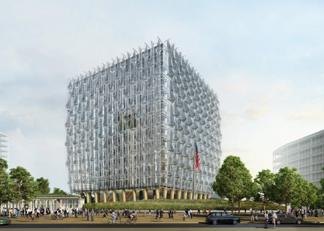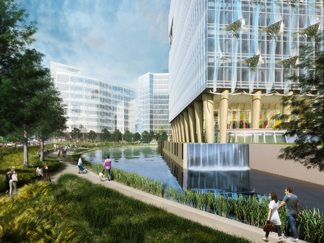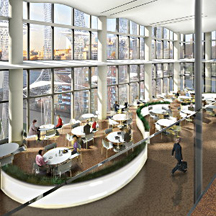
WASHINGTON — The U.S. Department of State has unveiled plans for a new embassy in London, a project that is expected to meet top United States and European environmental standards.
In February, the State Department named architectural firm KieranTimberlake as the project’s designer. The Philadelphia-based firm’s proposed design meets the goal of creating a modern, welcoming, and energy efficient embassy that is expected to achieve LEED Platinum certification and a Building Research Establishment Environmental Assessment Method rating of Outstanding — a top environmental rating in Europe. KieranTimberlake competed against 37 architectural firms to win the design competition.
The entire embassy project has a budget of $1 billion, but construction estimates have come in at $500 million.
Slated for a site in Greater London’s Nine Elms district, construction is scheduled to begin in 2013, with the goal of a 2017 completion date. The building will be located near several major pedestrian paths and public transportation stops. Inside, interior gardens will be scattered throughout.
Designers at KieranTimberlake aimed for a carbon-neutral structure with a self-sufficient water system that can exceed local and regional planning requirements and energy policies.

The embassy’s crystal-like ethylene tetrafluoroethylene (a corrosion-resistant plastic) scrim will be optimized to shade interiors from sunlight while admitting daylighting and offering expansive views. Thin film photovoltaics in the ETFE foils will convert sunlight to energy. The multilayered ETFE scrim will use pressurized air pocket to further insulate the glazing from thermal transfer.

On top of the building, a crystalline photovoltaic array will cover the entire roof, screening mechanical equipment from view. Approximately 89,000 square feet of crystalline and thin-fill photovoltaic cells will cover the building, providing 345,000-kilowatt hours of energy.
The embassy’s highly transparent façade will maximize natural day-lighting, working in conjunction with light shelves, optimized reflectors, and fiber optic collectors, which will bring daylight into the interior of the building. Electric lighting will use occupancy and daylight sensors.
A biomass-fueled cogeneration plant will meet the embassy’s heating and electricity needs, as well as that of some of the surrounding community. Absorption chillers that use waste heat from the cogeneration plant will generate cooling for the building, while a ground-level pond will be used for heat ejection instead of cooling towers. An under-floor air distribution system, along with passive chillers and perimeter thin film radiators, will meet peak heating and cooling needs.
For water consumption, the embassy will utilize an onsite deep-well aquifer and an on-site wastewater treatment plan, the latter of which will collect grey-water from faucets and wastewater from toilets and treat it so that it can be reused for flush fixtures. Roof rainwater and property storm water runoff will be collected for irrigation and cooling systems use.
Once building is completed, the State Department plans to sell its current London Embassy, located in London’s Mayfair area.
The State Department currently has three LEED-certified embassies in Panama City, Panama; Sofia, Bulgaria; and Johannesburg, South Africa.

